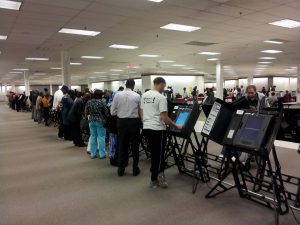- Provides Support and Guidance for Safe, Secure, and Accurate 2020 General Election
- $12,861,311 Federal CARES Act funds for the 2020 election
Ohio Secretary of State Frank LaRose has issued Directive 2020-11 to the state’s 88 county boards of elections on how to ensure a safe, secure and accurate 2020 General Election.
The “Ready for November Directive” details how counties must utilize federal dollars to improve their election infrastructure, hire temporary personnel, enhance their supply of personal protective equipment (PPE), and recruit poll workers.
Ohio’s share of federal CARES Act funds designated for the 2020 election is $12,861,311. Notably, 87% of Ohio’s federal dollars will be sent directly to the county boards of elections in support of their efforts to run a safe, secure, and accurate election.
“Over the past several months, we’ve been working with bipartisan election officials across Ohio as well as election experts and advocates to make our state ready for November,” said Secretary Frank LaRose.
“While we certainly have many challenges ahead of us, this plan puts us on a path to ensure Ohio voters will be confident that their voice was heard on November 3rd.”
The Ready for November Directive provides required guidance on the following:
Recruiting More Poll Workers. For county boards of elections to be able to open the appropriate number of polling locations on Election Day, they must first recruit and train enough poll workers to satisfy the minimum required by state law to operate a precinct. Traditionally, Ohio utilizes over 35,000 poll workers on Election Day. Because of the current pandemic, fewer poll workers are expected to sign up or show up on Election Day. Because of this anticipated shortage, unprecedented efforts must be made to recruit new poll workers and backups. Additionally, Boards must prepare and plan for the possibility of poll worker shortages and the contingencies necessary should that situation arise. By August 1, 2020, county boards of elections must send a survey to every poll worker who served previously within the last three years or who indicated to the board their interest in serving in the 2020 primary election. This is a significant advance of the traditional timeline utilized by county boards of elections to begin poll worker recruitment preparations.
More Election Infrastructure. To better manage the expected increase in absentee voting, counties are required to utilize the funds to obtain the equipment necessary to manage the mailing, processing and tabulation of absentee ballots. This is in addition to the $117 million provided by the state of Ohio and spent by county boards of elections in the previous two years to modernize election equipment.
PPE to Keep Poll Workers and Voters Safe. The Center for Disease Control (CDC) has provided detailed guidance designed to keep voting locations safe. County boards of elections will receive funds that they will use to procure the supplies necessary to meet those recommendations.
Increasing County Board of Elections Staff. With record-turnout and a higher reliance upon absentee voting expected, county boards are required to utilize the new federal dollars to boost temporary staffing ahead of the November election.
Faster Fixes for Absentee Voters. Sometimes voters utilizing absentee voting may neglect to provide all the required information, signature, or other requirements. While previously these voters would only be notified by mail, county boards are now directed to utilize any e-mail or phone contacts available, in addition to also sending a written notice, to inform voters of the shortfall and provide them information on how to quickly rectify the situation.
Additional Ballot Printing. Increasing the minimum number of printed ballots, including absentee and provisional ballots, ensures there are enough ballots so shortages cannot happen.
Paper Backups to Electronic Equipment. Electronic pollbooks are in wide use across Ohio. In order to make available an additional level of security and redundancy, boards are required to use federal dollars to ensure that every voting location has paper backups of the voter information contained in electronic pollbooks.
Relocating Polling Locations Used by Vulnerable Populations. If a board of elections has not done so already, county boards of elections must relocate any polling location currently at a residential senior citizen facility or health care facility. Relocation must occur even if voting takes place in a separate building on the same property, such as a community center or activity room.
Utilization of Schools as Polling Locations. Because of the aforementioned relocation of certain polling locations, new ones must be obtained. As required by state law, Ohio schools should provide their facilities to serve as voting locations. County Boards of Elections must contact schools in their communities to confirm their availability and request additional locations, and schools should consider the best practice of closing to instruction on Election Day.
Assisting Voters in Senior Living and Health Care Facilities. Voters in these facilities may not have the same voting option accessibility to the voting options to which they have become accustomed. County boards of elections must put a plan in place to send elections staff to these facilities to safely help individuals cast their vote or deputize facility personnel as Special Elections Officials to ensure these voters have their voice heard.
Additional Assistance for Voters Physically Unable to Enter a Polling Location. County boards of elections must offer curbside voting for voters physically unable to enter polling locations.

































Leave a Reply
You must be logged in to post a comment.